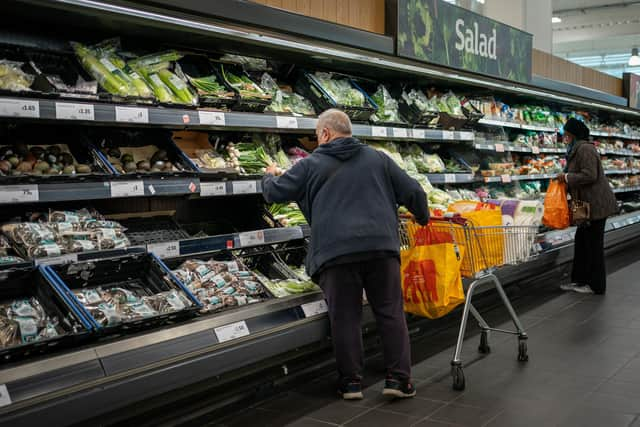Grocery inflation sees fastest monthly drop as households spending hits all-time high
Grocery prices are now 6.7 per cent higher than a year ago, the lowest level since April 2022 and a plunge from November’s inflation figure of 9.1 per cent, analysts at Kantar reported.
It came as supermarkets experienced their busiest Christmas since 2019, with Britons making 488 million trips to the supermarkets over the four weeks to December 24, which is 12 million more than the year before, and sending a record £13.7bn through the tills.
Advertisement
Hide AdAdvertisement
Hide AdThe average household spent £28 more on groceries across the month than in December 2022, with total take-home sales up 7 per cent in value and the number of items bought up 2 per cent.


December 22 was the most popular shopping day, when just over 25 million trips were made and consumers spent £803m in physical stores – 85 per cent more than the average Friday in 2023.
Online’s share of the market held steady at 11.6 per cent, as nearly one in five households received a delivery in preparation for Christmas Day.
Consumer appetite for the traditional Christmas dinner was particularly strong, with sales volumes of parsnips, sprouts and potatoes up 12 per cent, 9 per cent and 8 per cent respectively, sales of chilled gravy up by 11 per cent and festive meat including pigs in blankets, sausages, hams and turkeys up by 6 per cent collectively.
Advertisement
Hide AdAdvertisement
Hide AdHowever, mince pies and Christmas puddings bucked the trend, with sales volumes falling by 4 per cent and 7 per cent respectively – although fresh cream was up by 5 per cent across the month, suggesting dessert remained on the menu.
Fraser McKevitt, head of retail and consumer insight at Kantar, said: “The rate of inflation is coming down at the fastest pace we have ever recorded, but consumers are still facing pretty hefty pressures on their budgets.
“Retailers were clearly working hard during the festive period to offer best value and win over shoppers, and promotions were central to their strategy.
“Nearly one third of all spend in the four weeks to Christmas Eve was made on items with some kind of offer, the highest level since December 2020 and £823m more than last year.”
Advertisement
Hide AdAdvertisement
Hide AdTesco, Sainsbury’s, Asda, Morrisons and Waitrose accounted for a combined market share of 70 per cent over the quarter to December 24.
Mr McKevitt added: “The traditional retailers always tend to do well in the run up to Christmas and this year was no exception. Supermarkets saw especially strong performances for their own-label lines, with sales of premium ranges like Sainsbury’s Taste the Difference and Tesco Finest surging by 11.9 per cent compared with last year to hit £790 million – accounting for 5.7 per cent of all grocery sales.
"Branded sales rose by 6.0 per cent during the same period.”
Kantar monitors the take home grocery purchasing habits of 30,000 demographically representative households across Great Britain. This includes all expenditure through store tills, excluding petrol and in-store concessions.
Comment Guidelines
National World encourages reader discussion on our stories. User feedback, insights and back-and-forth exchanges add a rich layer of context to reporting. Please review our Community Guidelines before commenting.